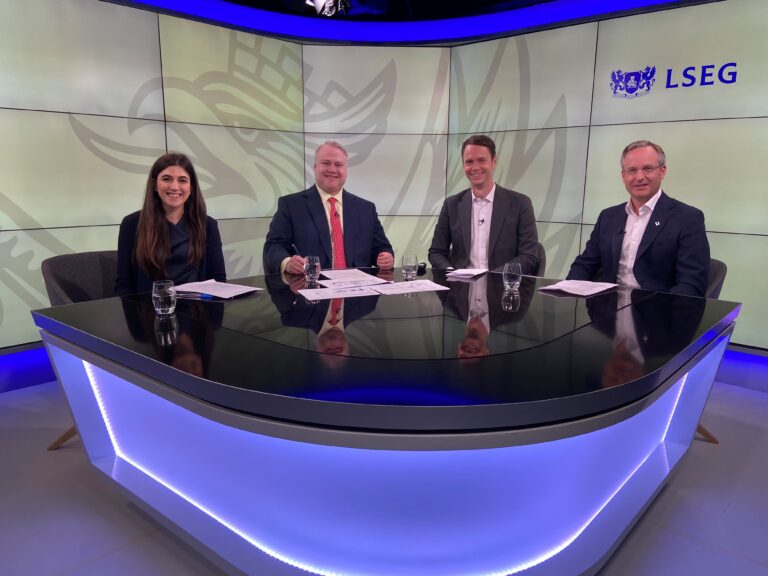The recent award-winning collaboration between Turquoise, FlexTrade Systems and OpenFin has delivered a game-changing innovation which simplifies the workflow for buy-side traders. Our Data and Desktop Workflow Innovation earned the Financial News ‘Fintech Innovation of the Year’ Award 2022.
Athina Trika, Senior Manager, Buyside & Business Development Securities Trading at LSEG, interviews Dr. Robert Barnes (Group Head of Security Trading and CEO of Turquoise, LSEG), Andy Mahoney (Managing Director, EMEA, FlexTrade Systems) and Adam Toms (CEO, OpenFin Europe) for more insight into this new workflow, which delivers Turquoise data and real-time block activity information directly to the buy-side trader’s desktop. We also explore how Turquoise, FlexTrade and OpenFin have worked together to develop this innovation and bring the functionality to the market.
Dr Robert Barnes – starting with Turquoise, can you give us some context on what have been the drivers of this initiative?
Over the last few years, we have had the privilege of introducing a new service, Turquoise Plato Block Discovery™. The objective was to address the problem of shrinking trade sizes by introducing midpoint and electronic block trading, featuring high firm ups, high-quality execution evidenced by low price reversion and high trade size.
Since 2013, we have seen record levels of activity with the average daily turnover continuing to grow. The size of trades also continues to grow. We now regularly see trades above €20mln with the largest single trade above €27mln. This suggests users are clearly benefitting from midpoint and electronic block trading. Thanks to the community, Turquoise Plato® has been the destination of choice for fully automated midpoint and electronic block trading.

Through our award-winning innovation and the collaboration of Turquoise, FlexTrade and OpenFin, we are able to deliver real-time block activity information directly to a buy-side trader’s desktop. By auto-populating their execution systems, the buy-side will be able to increase the probability of capturing electronic block trades.
Andy Mahoney at FlexTrade – how does FlexTrade deliver the relevant information and Turquoise Plato® data to the buyside user?
Clients have been asking for actionable intelligence on their blotter, which will change how they route orders based on automation or alerts. OpenFin’s involvement meant FlexTrade could focus on the innovation to deliver the data directly into the EMS with minimal development.
Within our execution management system blotter, we built analytics content delivered straight from Turquoise around the largest block traded, the number of shares and quantity of executions. The data is deeply embedded in the EMS, which can be used to produce various calculations, for example, how much of an order sitting on your trading blotter has traded already as a block on Turquoise. This is clearly valuable information for the buy-side trader, who can compare these analytics to their own activity and then decide to include Turquoise as part of their order routing decision. The Turquoise data feed broadcast through the OpenFin bus is communicated directly to the buy-side trader on screen.
Adam Toms at OpenFin – can you tell us about application interoperability and OpenFin’s industry initiative? Why is this relevant for the buy-side trader?
If we take a step back and think of the rich data that can be delivered, these offer important information and insights for the buy-side trader. However, these data insights are generated from countless different sources. In fact a trader might be using more than 30 applications a day, switching between these apps over 1,100 times a day. This is hugely detrimental to productivity and opportunity. Today, we must think about interoperability – the ability to connect these applications together – and invest in tools that can deliver information while reducing some of these burdens that traders and knowledge workers are experiencing.
OpenFin is an open, neutral, collaborative platform, providing a centralised desktop component to deliver valuable information and useful functionality such as alerts, search functions and a notification centre. Interoperability enables us to take important data for traders and connect it seamlessly, reducing switching between apps and thus significantly reducing friction. By removing bilateral integrations, we are creating a standardised approach to how traders exchange information on the desktop.
Being able to receive rich information from Turquoise, while simultaneously reducing development costs, it is a win across the board for the industry.
Dr Robert Barnes – what are the market observations that make this innovation relevant now?
We are very happy that Turquoise Plato® has become the destination for fully-automated midpoint and electronic block trading, particularly at large values – a trend which has become mainstream. In fact, the size of trades continues to grow. We are also beginning to see large trades in individual country stocks.
For example, we recently had our number one trades in each of a Swiss and a Danish stock. Activity is at record highs while there is plenty of capacity to provide consistent high-quality execution. Individual block indications can be more than £100 million/€100 million, such that we have raised the order entry limit to £200mln / €200mln.
Plus, we are also beginning to see that with the market adopting electronic block trading, high-quality executions tend to cluster. We often observe that when a block trade happens there are more block trades that follow creating clusters of liquidity.
And just how flexible and customisable is this workflow? Back to you, Andy.
Very flexible. Once FlexTrade received data from the OpenFin bus, it was just a matter of working out what we wanted to do with it. Workshopping with clients and peers, we identified key functionality requirements. Use cases include automated routing and graphical visualisation. As data is embedded deeply into the blotter, the user can sort, filter and build customized alerts. Continuing with our overall approach, we also extended customization to automated trading as well, as part of our automated algo wheel capabilities. This way, users can route an order through to their preferred brokers or include it as part of their algo wheel. Users can take the data and do whatever they want with it – say, compare it with EBBO or previous trade history. What this development does offer, however, is the opportunity to auto-populate the next trading ticket to capture liquidity opportunities.
And Robert, how does Turquoise interact with the buyside desktop via this innovation?
LSEG worked with OpenFin and FlexTrade to integrate and interoperate directly with the buy-side. The buy side can set rules, through their execution system, that auto-populate tickets to send orders right back to Turquoise when the system observes activity above user defined thresholds, thus increasing the probability of capturing the follow-on natural liquidity as electronic block trades. Because the buyside desktop is ingesting Turquoise data, this model ensures there is no risk of potential information leakage from the buy-side desktop.
Andy, how open is the integration of this workflow across the broader community?
This is a true open architecture platform. Previously developers would have had to build bilateral API connections. OpenFin puts a sanitization layer between FlexTrade and Turquoise, meaning we only needed to build once to OpenFin, and everything else was taken care of. In short, it allows other vendors and applications on the desktop to consume the same data, without having to rebuild the infrastructure into Turquoise.
A question to all three of you – what are the next steps in this evolution?
Adam Toms: We have made great strides in producing important data insights. The next step is around personalising this information and ensuring it is relevant for the user at the right point of their workflow to most impactful for them.
Andy Mahoney: The focus should be on the workflow rather than the application. We must ask how a user traverses all their applications effectively and efficiently – and how the workflow can be tailored to achieve the minimum number of clicks towards a desired outcome and, with that, getting the data into the EMS and the OMS and other systems to ensure best outcomes. The next step is determining the recommended route based on historical activity. This is a step change for the industry to standardise but something we are already investing in, with advances in machine learning and artificial intelligence.
Robert Barnes: As a market operator, it is a privilege to work with thought leaders like Adam Toms and Andy Mahoney to bring innovative solutions to market participants, so that we can enable investors to capture liquidity at the right price in an efficient way.
Finally, Adam Toms and Dr Robert Barnes – what does this collaboration mean for future innovation?
Robert Barnes: Standardisation enables us to scale and bring timely innovations to market. This is the first time we had three different actors across the trade cycle cooperating to bring this innovation to the buy-side trader and wider industry.
Adam Toms: Working with Turquoise and FlexTrade, demonstrates how firms can adopt a new approach and work together to surface important data on people’s desktops.
With regards to the future, it’s great that people are talking about interoperability. But we need increased open and neutral approach through more participation from other providers in the ecosystem, given the opportunity they can bring.
For help and more information, please contact our Turquoise Team
sales@tradeturquoise.com +44 (0) 20 7382 7650









